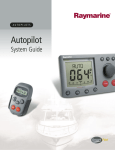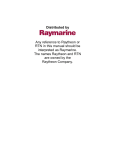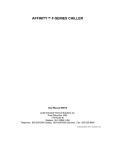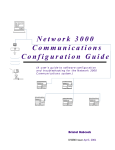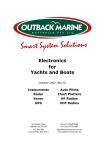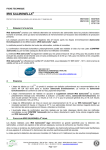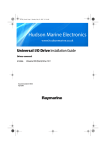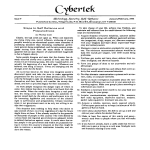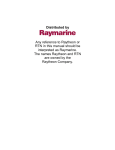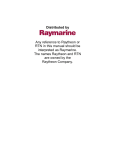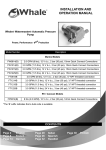Download Raymarine 150/400 Installation guide
Transcript
Linear Drive Installation Guide Drives covered: M81130 Type 1 Linear Drive 12 V M81131 Type 2 (short) Linear Drive 12 V M81132 Type 2 (long) Linear Drive 12 V M81133 Type 2 (short) Linear Drive 24 V M81134 Type 2 (long) Linear Drive 24 V Document number: 81175-5 February 2007 4 Important information Safety notices WARNING Product installation This equipment must be installed in accordance with the instructions contained in this handbook. Failure to do so could result in poor product performance, personal injury and/or damage to your boat. Because correct performance of the boat’s steering is critical for safety, we STRONGLY RECOMMEND that an Authorized Raymarine Service Representative fits this product. WARNING Navigation aid When this product is used within a navigation system, it is only an aid to navigation. It’s accuracy can be affected by many factors, including equipment failure or defects, environmental conditions and improper use or handling. It is the user’s responsibility to exercise common prudence and navigational judgements. This product should not be relied upon as a substitute for such prudence and judgement. Always maintain a permanent watch so that you can respond to situations as they develop. EMC conformance All Raymarine equipment and accessories are designed to the best industry standards for use in the recreational marine environment. The design and manufacture of Raymarine equipment and accessories conform to the appropriate Electromagnetic Compatibility (EMC) standards, but correct installation is required to ensure that performance is not compromised. Handbook information To the best of our knowledge, the information in this handbook was correct when it went to press. However, Raymarine cannot accept liability for any inaccuracies or omissions it may contain. In addition, our policy of continuous product improvement may change specifications without notice. As a result, Raymarine cannot accept liability for any differences between the product and the handbook. 5 Waste Electrical and Electronic Equipment Directive The Waste Electrical and Electronic Equipment (WEEE) Directive requires the recycling of waste electrical and electronic equipment. Whilst WEEE does not apply to some of Raymarine’s products, we support its policy and ask you tobe aware of how to dispose of this product. The crossed out wheelie bin symbol, illustrated above, and found on our products signifies that this product should not be disposed of in general waste or landfill. Please contact your local dealer, national distributor or Raymarine Technical Services for information on product disposal. Warranty To register your new Raymarine product, please take a few minutes to fill out the warranty card. It is important that you complete the owner information and return the card to receive full warranty benefits. Alternatively you can register your product at; www.raymarine.com 6 Introduction Product description Welcome to the installation guide for the Raymarine linear drive. This product is intended to operate the boat’s steering mechanism as part of a Raymarine autopilot system. It is designed for boats with existing mechanical steering systems. CAUTION Linear drive This drive moves the rudder directly from the tiller arm or rudder quadrant. Before installing the drive, check that the boat’s steering system can be backdriven from the rudder.. The outstanding design of the Raymarine linear drive unit provides: • powerful thrust, fast hardover times and quiet operation • low backdrive force, to minimize the drive’s effect on the boat’s steering when the autopilot is in standby • a powerful electric motor controlled by an electromagnetic fail-safe clutch, using a high tensile belt drive and epicyclic gearbox • high performance for minimum current consumption Clutch cable Push rod Rod end Motor cables Mounting foot Motor, gearbox and clutch assembly Figure 1: Main parts of the linear drive D5075-1 7 Contents This guide contains: 1 Product specifications page 7 2 Installation instructions page 8 3 Maintenance information page 17 Specifications Drive specifications Table 1-1: Drive specifications Performance* (at nominal voltage) Type 1 (T1) M81130 (12 V) Type 2 short (T2S) M81131 (12 V) M81133 (24 V) Type 2 long (T2L) M81132 (12 V) M81134 (24 V) Maximum boat displacement 10,000 kg (22,000 lb) 15,000 kg (33,000 lb) 20,000 kg (44,000 lb) Peak thrust 295 kg (650 lb) 480 kg (1,050 lb) 480 kg (1,050 lb) Maximum stroke 300 mm (12 in) 300 mm (12 in) 400 mm (16 in) Hardover to hardover time (+/- 35º, no load) 11 sec 11 sec 14 sec Maximum rudder torque 735 Nm (6,500 lb.in) 1,190 Nm (10,500 lb.in) 1,660 Nm (14,700 lb.in) Power consumption (typical average) 18-36 W Other information (applies to Types 1 and 2 short/long) 48-72 W (12 V) 66-96W (24 V) protected for use in engine compartments CE approvals - conforms to: 89/336/EC (EMC), EN60945:1997 94/25/EC (RCD), EN28846:1993 8 Drive dimensions 50 mm (2 in) 197 mm (7.8 in) A (midstroke) 114 mm (4.5 in) 79 mm (3.1 in) 90º 4 fixing holes suitable for 10 mm (0.4 in) bolts Drive Type 1 Type 2 (short) Type 2 (long) Dimension 'A' 700 mm (27.5 in) 700 mm (27.5 in) 850 mm (33.5 in) D5081-1 Figure 2: Linear drive dimensions Installation instructions Parts required To install this drive you will need: • Parts supplied: • linear drive • mounting foot assembly, consisting of: foot, pivot pin, washer (x2), R-clip (x2) • tiller pin assembly (see Figure 6 ) consisting of: tiller pin, R-clip, top washer, lock washer, nut (1/2 inch UNC nylock) • Additional parts: • suitable securing bolts and lock nuts/lock washers (see page 13) • suitable cable and electrical connectors for the drive motor and clutch (see page 15) Note: Make sure you have obtained these additional parts before you start installation. 9 Installation steps WARNING Electrical safety Make sure you have switched OFF the power supply before you start installing this product. Follow these steps to install your linear drive unit: 1 Consult the EMC installation guidelines. page 9 2 Mount the drive. page 11 3 Connect to the course computer. page 15 4 Complete the post-installation check. page 16 1. EMC installation guidelines All Raymarine equipment and accessories are designed to the best industry standards for use in the recreational marine environment. Their design and manufacture conforms to the appropriate Electromagnetic Compatibility (EMC) standards, but correct installation is required to ensure that performance is not compromised. Although every effort has been taken to ensure that they will perform under all conditions, it is important to understand what factors could affect the operation of the product. The guidelines given here describe the conditions for optimum EMC performance, but it is recognized that it may not be possible to meet all of these conditions in all situations. To ensure the best possible conditions for EMC performance within the constraints imposed by any location, always ensure the maximum separation possible between different items of electrical equipment. For optimum EMC performance, it is recommended that wherever possible: • Raymarine equipment and cables connected to it are: 10 • At least 3 ft (1 m) from any equipment transmitting or cables carrying radio signals e.g. VHF radios, cables and antennas. In the case of SSB radios, the distance should be increased to 7 ft (2 m). • More than 7 ft (2 m) from the path of a radar beam. A radar beam can normally be assumed to spread 20 degrees above and below the radiating element. • The equipment is supplied from a separate battery from that used for engine start. Voltage drops below 10 V, and starter motor transients, can cause the equipment to reset. This will not damage the equipment, but may cause the loss of some information and may change the operating mode. • Raymarine specified cables are used. Cutting and rejoining these cables can compromise EMC performance and must be avoided unless doing so is detailed in the installation manual. • If a suppression ferrite is attached to a cable, this ferrite should not be removed. If the ferrite needs to be removed during installation it must be reassembled in the same position. Suppression ferrites The following illustration shows typical cable suppression ferrites used with Raymarine equipment. Always use the ferrites supplied by Raymarine. This product has ferrites mounted internally. D3548-2 Figure 3: Typical suppression ferrites Connections to other equipment If your Raymarine equipment is to be connected to other equipment using a cable not supplied by Raymarine, a suppression ferrite MUST always be attached to the cable near to the Raymarine unit. 11 2. Mounting the drive Mounting the drive unit involves four main steps: • • • • ensuring correct drive alignment securing the drive to the boat connecting the drive to the steering system completing a steering check Drive alignment When mounting the linear drive unit, check that it is aligned correctly: • The main drive assembly must be at right angles to the mounting surface (see Figure 4 ). • The drive unit must be at right angles to the tiller arm when the rudder is amidships (see Figure 4 ). Side view A (mid stroke) 90º Drive Type 1 Type 2 short Type 2 long A (mid stroke) 700 mm (27.5 in) 700 mm (27.5 in) 850 mm (33.5 in) B (tiller arm radius) 250 mm (10 in) 250 mm (10 in) 355 mm (14 in) Top view 90º B (tiller arm radius) D5077-1 Figure 4: Drive unit alignment • The push rod must be accurately aligned with the tiller arm plane of rotation. The ball end fitting only allows up to 5 degrees misalignment between the push rod and tiller arm plane of rotation (see Figure 5 ). CAUTION Alignment Accurate angular alignment is extremely important. You must not exceed this +/- 5 degree limit under any circumstances. 12 5º Max. 5º Max. D5078-1 Figure 5: Alignment between push rod and tiller arm plane of rotation Securing the drive Mounting location Before you secure the drive to your boat, you must first check the suitability of the mounting location. CAUTION Mounting location Consult the boat manufacturer if you have any doubt about the strength or suitability of the mounting location. • Structural strength: • This drive produces a considerable amount of force, so you must mount it on a solid structure (i.e. a substantial frame member) in the boat. In some cases you may need to build a special frame to mount the drive unit. • To prevent excess noise and vibration, do not attach this drive to any structures that support cabins. • Drive orientation: • You can attach the drive unit mounting foot to any suitable horizontal or vertical surface. If required, you can also mount the drive unit upside down. • General position: • Refer to the EMC installation guidelines (page 9) • Make sure the drive will be accessible for future servicing. • Environment: • This drive is not waterproof, so you should mount it in a dry location, clear of any bilge water. 13 Securing bolts Attach the mounting foot with four stainless steel M10 (3/8 inch) bolts and lock nuts/lock washers. Note: Always mount the drive as securely as possible to make sure it performs reliably and remains cor- rectly aligned. Connecting to the steering system CAUTION Equipment strength Consult the steering gear manufacturer if you have any doubt about the strength of the existing tiller arm or rudder quadrant. This drive produces a considerable amount of force, so you must ensure that your tiller arm or rudder quadrant can cope with the peak thrust specified in the Table 1-1, Drive specifications. Use one of these methods to attach the push rod to the rudder stock: 1. Independent tiller arm: we recommend that you attach the linear drive unit to the rudder stock via an independent tiller arm (the Edson and Whitlock companies offer standard fittings for their steering systems). 2. Steering linkage tiller arm or rudder quadrant: in certain cases, you may be able to attach the push rod to the same tiller arm or rudder quadrant used by the main steering linkage. Consult the steering manufacturer before you modify the rudder quadrant. Attaching the rod end Use the supplied tiller pin assembly to attach the rod end to the tiller arm, at the tiller arm radius shown in Figure 4 . 1. Attach the tiller pin to the tiller arm: • insert the tiller pin through the tiller arm hole, so the flange remains above the arm (see Figure 6 ) • make sure that the tiller pin is a tight fit in the tiller arm • use the supplied lock washer and fully tighten the lock nut Note: If necessary, you will need to drill a 13 mm (0.52 in) hole in the tiller arm at the radius shown in Figure 4 . 2. Attach the rod end to the tiller pin: • place the rod end onto the tiller pin • secure with the supplied washer and R-clip (see Figure 6 ) 14 R-clip Washer Rod end Flange Tiller arm Lock nut Lock washer Tiller pin Hole diameter 13 mm (0.52 in) D5076-1 Figure 6: Attaching the push rod to the tiller arm Steering check When you have mounted the drive unit, turn the boat’s steering wheel from hardover to hardover and check that: • Angular movement of the ball end fitting is less than 5 degrees (see Figure 5 ). If you exceed this 5 degree limit, the drive will catch on the tiller arm/rudder quadrant and the ball joint will bind. • No part of the drive unit fouls the boat’s structure when the push rod moves in and out. • The total rudder movement is limited to +/- 35 degrees by the steering system end stops rather than the linear drive’s end limits (see Figure 7 ). Steering system end stop Steering system end stop 35º 35º D5079-1 Figure 7: Total rudder movement CAUTION Linear drive Make sure rudder movement is limited by the steering system end stops before the push rod reaches its end stop. Failure to do this could damage the drive and will invalidate the warranty. 15 WARNING Moving parts Keep clear of moving steering systems at all times. Protect moving parts from access during normal use. 3. Connecting to the course computer WARNING Electrical safety Make sure the power supply is switched OFF before you make any electrical connections. The linear drive unit has electrical connections for: • the drive motor: two single-core cables: red and black • the clutch: a two-core cable with red (+) and blue (-) cores Follow these steps to connect the linear drive to the course computer: 1. Measure the distance of cable run from the drive unit to the course computer: • use Table 1-1 to identify the appropriate motor cable size • use at least 1.5 mm2 (16 AWG) copper cable for the clutch 2. Join these cables to the drive cables using appropriate electrical connectors or junction boxes at the correct power rating. 3. Route the cables back to the course computer, taking into account the EMC installation guidelines (see page 9). 4. Connect the cables to the course computer (see Figure 8 ): • CLUTCH cable: red core to +ve, blue core to -ve • MOTOR cables: at this stage you can connect either motor cable to either terminal. You will check these connections after installing the rest of the autopilot system. 16 OFF SWITCH – + A B POWER MOTOR – – – + – + lk CLUTCH SOLENOID CLUTCH Type 150/400 course computer – + 1 2 POWER MOTOR Type 100/300 course computer D5080-1 Figure 8: Cable connections at course computer Table 1-1: Recommended cable sizes Cable length (drive unit to course computer) Cable gauge (AWG) Copper area (mm2) Type 1 drive up to 3m (10ft) up to 5m (16ft) up to 7m (23ft) up to 10m (32ft) up to 16m (52ft) 14 12 10 8 6 2.5 4 6 10 16 Type 2 drive 12 V (short/ long) up to 5m (16ft) up to 7m (23ft) up to 16m (52ft) 10 8 6 6 10 16 Type 2 drive 24 V (short/ long) up to 3m (10ft) up to 5m (16ft) up to 10m (32ft) up to 16m (52ft) 12 10 8 6 4 6 10 16 4. Post installation checklist Check the following points after installing the drive: 1. Is the mounting foot secured to a substantial structure on the boat? 2. Is the drive unit correctly aligned, i.e: • Is the mounting foot correctly oriented? 17 • Is the drive mounted at right angles to the tiller arm, in a mid-stroke position, when the rudder is amidships? • Is the push rod accurately aligned with the tiller arm plane of rotation (less than 5 degrees variation)? 3. Is the linear drive rod end: • securely attached to the tiller arm or quadrant? • attached at the recommended tiller arm radius for the boat? 4. Are the motor and clutch cables correctly routed and securely connected to the course computer? 5. Have you completed a hand-steering check (see page 14)? Note: When you have installed the entire autopilot system, you will need to complete an autopilot steering check. Refer to the control unit handbook for more details. Maintenance Please make the following checks before each passage: • • • • Ensure that all connections and mountings are secure. Ensure that the drive is aligned correctly. Ensure that cables have no signs of wear or damage. Check for unusual noisy operation, such as clicking or grinding noises, or unusual vibration. If any of these are detected, the drive must be taken to a Raymarine authorized service representative before further use. • Ensure that the drive is not wet or exposed to water. • Ensure that the swivel joint and rose-end are lightly greased with waterproof grease. Note: The drive should be serviced every 2 years or 1000 hours of use, whichever comes first, by a Ray- marine authorized service representative. EMC servicing and safety guidelines • Raymarine equipment should be serviced only by authorized Raymarine service representitives. They will ensure that service procedures and replacement parts used will not affect performance. There are no user serviceable parts in any Raymarine product. • Some products generate high voltages, so never handle the cables/connectors when power is being supplied to the equipment. • When powered up, all electrical equipment produces electromagnetic fields. These can cause adjacent pieces of electrical equipment to interact with one another, with a consequent adverse effect on operation. In order to minimize these effects and enable you to get the best possible performance from your Raymarine equipment, guidelines are given in the installation instructions, to enable you to ensure minimum interaction between different items of equipment, i.e. ensure optimum Electromagnetic Compatibility (EMC). 18 • Always report any EMC-related problem to your nearest Raymarine dealer. We use such information to improve our quality standards. • In some installations, it may not be possible to prevent the equipment from being affected by external influences. In general this will not damage the equipment but it can lead to spurious resetting action, or momentarily may result in faulty operation. Product support Raymarine products are supported by a worldwide network of distributors and Authorized Service Representatives. If you encounter any difficulties with this product, please contact either your national distributor, or your service representative, or the Raymarine Technical Services Call Center. Refer to the back cover or the Worldwide Distributor List for contact details. Raymarine Inc Raymarine Ltd 21 Manchester Street Anchorage Park Merrimack Portsmouth, Hampshire NH 03054-4801, USA England PO3 5TD Telephone +1 603 881 5200 Telephone +44 (0)23 9269 3611 Fax +1 603 864 4756 Fax +44 (0)23 9269 4642 www.raymarine.com www.raymarine.com Raymarine Technical Services Call Center UK: +44 (0)23 9271 4713 or USA: +1 603 881 5200 +44 (0)23 9269 3611 ext. 1083
















